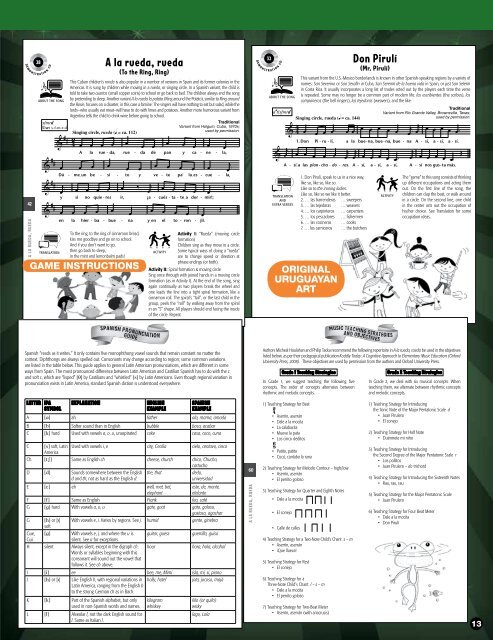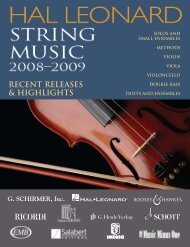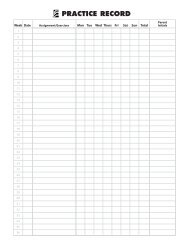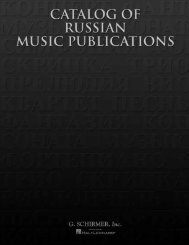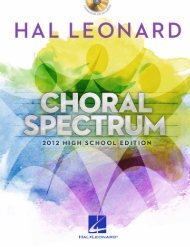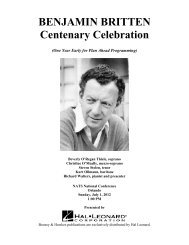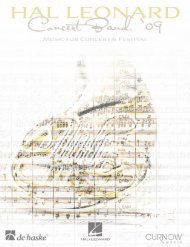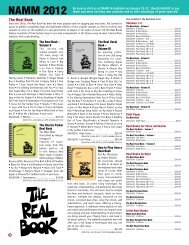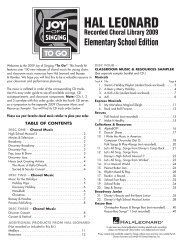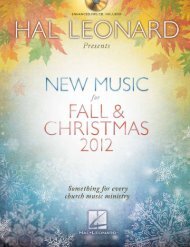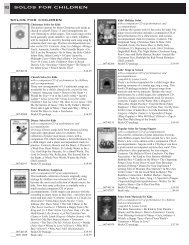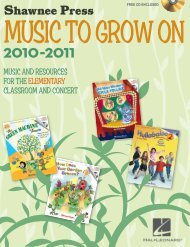musicals - Hal Leonard
musicals - Hal Leonard
musicals - Hal Leonard
You also want an ePaper? Increase the reach of your titles
YUMPU automatically turns print PDFs into web optimized ePapers that Google loves.
42<br />
A L A R u e dA , R u e dA<br />
28<br />
About the Song<br />
sfmrd<br />
Use: s-f-m-r-d<br />
& # #<br />
& # #<br />
& # #<br />
tRAnSLAtIon<br />
& # # 4<br />
2<br />
A la rueda, rueda<br />
(To the Ring, Ring)<br />
This Cuban children’s ronda is also popular in a number of versions in Spain and its former colonies in the<br />
Americas. It is sung by children while moving in a rueda, or singing circle. In a Spanish variant, the child is<br />
told to take two cuartos (small copper coins) to school or go back to bed. The children always end the song<br />
by pretending to sleep. Another variant A la rueda la patata (Ring around the Potato), similar to Ring around<br />
the Rosie, focuses on a disaster, in this case a famine: The singers will have nothing to eat but salad, while the<br />
lords—who usually eat meat—will have to do with limes and potatoes. Another more humorous variant from<br />
Argentina tells the child to drink wine before going to school.<br />
Singing circle, rueda (q = ca. 112)<br />
œ œ œ œ<br />
To the ring, to the ring of cinnamon bread,<br />
kiss me goodbye and go on to school.<br />
And if you don’t want to go,<br />
then go back to sleep,<br />
in the mint and lemonbalm pads!<br />
œ œ œ<br />
œ œ œ<br />
A la rue - da, rue - da de pan y ca - ne - la,<br />
œ œ œ<br />
Dá - meIun be - si - to y ve - te pa' laIes - cue -<br />
œ<br />
y<br />
j<br />
œ œ œ œ<br />
si no quie - res<br />
œ œ œ œ<br />
en la hier - ba - bue<br />
œ œ œ<br />
game instructions<br />
œ<br />
œ œ œ œ<br />
œ ‰ j œ œ œ œ œ<br />
ir, ¡a -<br />
œ<br />
œ œ œ œ<br />
-<br />
na<br />
cués - ta - teIa dor - mir!;<br />
yIen el to - ron - jil.<br />
Traditional<br />
Variant from Holguín, Cuba, 1970s;<br />
used by permission.<br />
Activity I: “Rueda” (moving circle<br />
formation)<br />
Children sing as they move in a circle.<br />
ActIvIty Some typical ways of doing a “rueda”<br />
are to change speed or direction at<br />
phrase endings (or both).<br />
Activity II: Spiral formation & moving circle<br />
Sing once through with joined hands in a moving circle<br />
formation (as in Activity I). At the end of the song, sing<br />
again continually as two players break the wheel and<br />
one leads the line into a tight spiral formation, like a<br />
cinnamon roll. The spiral’s “tail”, or the last child in the<br />
group, peels the “roll” by walking away from the spiral<br />
in an “S” shape. All players should end facing the inside<br />
of the circle. Repeat.<br />
œ<br />
œ<br />
œ<br />
œ<br />
Œ<br />
œ<br />
Œ<br />
j œ<br />
la,<br />
32<br />
About the Song<br />
d tlsfmrd<br />
&<br />
j œ<br />
& 4<br />
tRAnSLAtIon<br />
AnD<br />
eXtRA veRSeS<br />
don Pirulí<br />
(Mr. Pirulí)<br />
This variant from the U.S.-Mexico borderlands is known in other Spanish-speaking regions by a variety of<br />
names: San Severino or San Serafín in Cuba, San Serenín de la buena vida in Spain, or just San Selerín<br />
in Costa Rica. It usually incorporates a long list of trades acted out by the players each time the verse<br />
is repeated. Some may no longer be a common part of modern life: los escribientes (the scribes), los<br />
campaneros (the bell ringers), las tejedoras (weavers), and the like.<br />
œ œ œ œ . œ œ<br />
4Singing<br />
circle, rueda (q = ca. 144)<br />
1. Don Pi - ru - lí, a la bue-na, bue - na, bue - na A - sí, a - sí, a - sí.<br />
œ œ œ œ œ j œ<br />
j œ<br />
1. Don Piruli, speak to us in a nice way,<br />
like so, like so, like so.<br />
Like so to the ironing ladies.<br />
Like so, like so we like it better.<br />
2. … las barrenderas … sweepers<br />
3. … las tejedoras … weavers<br />
4. … los carpinteros … carpenters<br />
5. … los pescadores … fishermen<br />
6. … las cocineras … cooks<br />
7. … los carniceros … the butchers<br />
œ œ œ œ œ j œ<br />
œ œ œ œ œ .<br />
A - síIa las plan - cha - do - ras. A - sí, a - sí, a - sí, A -<br />
original<br />
uruguayan<br />
art<br />
Traditional<br />
Variant from Rio Grande Valley, Brownsville, Texas;<br />
used by permission.<br />
ActIvIty<br />
j<br />
œ<br />
j œ<br />
œ œ œ œ . œ<br />
œ œ œ œ œ<br />
sí nos gus-ta más.<br />
The “game” to this song consists of thinking<br />
up different occupations and acting them<br />
out. On the first line of the song, the<br />
children can clap the beat, or walk around<br />
in a circle. On the second line, one child<br />
in the center acts out the occupation of<br />
his/her choice. See Translation for some<br />
occupation ideas.<br />
Œ<br />
47<br />
A L A R u e dA , R u e dA<br />
This game variant was shared by Julio Eloy Mesa of<br />
Fomento, Sancti Spiritus, Cuba.<br />
The original purchaser of this book has permission to reproduce this song for educational use in one school only. Any other is strictly prohibited.<br />
Copyright © 2010 by HAL LEONARD CORPORATION<br />
International Copyright Secured All Rights Reserved<br />
Spanish “reads as it writes.” It only contains five monophthong vowel sounds that remain constant no matter the<br />
context. Diphthongs are always spelled out. Consonants may change according to region; some common variations<br />
are listed in the table below. This guide applies to general Latin American pronunciations, which are different in some<br />
Copyright © 2010 by HAL LEONARD CORPOATION<br />
International Copyright Secured All Rights Reserved<br />
ways from Spain. The most pronounced difference between Latin American and Castilian Spanish has to do with the z<br />
and soft c, which are “lisped” [θ] by Castilians and “whistled” [s] by Latin Americans. Even though regional variation in<br />
pronunciation exists in Latin America, standard Spanish diction is understood everywhere.<br />
LeTTeR<br />
The original purchaser of this book has permission to reproduce this song for educational use in one school only. Any other use is strictly prohibited.<br />
IPA<br />
SYMBOL<br />
eXPLANATION<br />
eNGLISH<br />
eXAMPLe<br />
SPANISH<br />
eXAMPLe<br />
A [A] ah father ala, mama, amada<br />
B [b] Softer sound than in English bubble boca, acabar<br />
C [k] hard Used with vowels a, o, u, unaspirated coke casa, coco, cuna<br />
C [s] soft, Latin Used with vowels i, e city, Cecilia cielo, centavo, cinco<br />
America<br />
Ch [tS] Same as English ch cheese, church chico, Chucho,<br />
cartucho<br />
D [d] Sounds somewhere between the English<br />
d and th; not as hard as the English d.<br />
the, that<br />
E [E] eh well, met, bet,<br />
elephant<br />
dedo,<br />
universidad<br />
este, de, mente,<br />
elefante<br />
F [f] Same as English Frank feo, café<br />
G [g] hard With vowels a, o, u gate, goat gato, goloso,<br />
gustoso, agachar<br />
G [h] or [x]<br />
soft<br />
With vowels e, i. Varies by regions. See j. humid gente, ginebra<br />
Gue,<br />
Gui<br />
[g]<br />
With vowels e, i, and where the u is<br />
silent. See ü for exceptions.<br />
guitar, guess<br />
guerrilla, guiso<br />
H silent Always silent, except in the digraph ch. hour<br />
hora, hola, alcohol<br />
Words or syllables beginning with this<br />
consonant will sound out the vowel that<br />
follows it. See ch above.<br />
I [i] ee bee, me, Mimi isla, mi, si, piano<br />
J [h] or [x] Like English h, with regional variations in<br />
Latin America, ranging from the English h<br />
to the strong German ch as in Bach.<br />
holly, hotel<br />
jota, jocoso, majá<br />
K [k] Part of the Spanish alphabet, but only<br />
used in non-Spanish words and names.<br />
L [l] Alveolar l, not the dark English sound for<br />
l. Same as Italian l.<br />
kilogram<br />
whiskey<br />
kilo (or quilo)<br />
wisky<br />
lago, Lola<br />
60<br />
55<br />
A L A R u e dA , R u e dA<br />
A L A R u e dA , R u e dA<br />
The original purchaser of this book has permission to reproduce this song for educational use in one school only. Any other is strictly prohibited.<br />
Copyright © 2010 by HAL LEONARD CORPORATION<br />
The original purchaser of this book has permission to reproduce International this song Copyright for educational Secured All use Rights in one Reserved school only. Any other use is strictly prohibited.<br />
Authors Micheal Houlahan and Philip Tacka recommend the following repertoire in A la rueda, rueda be used in the objectives<br />
Copyright © 2010 by HAL LEONARD CORPOATION<br />
listed below, as per their pedagogical publication Kodály<br />
International<br />
Today:<br />
Copyright<br />
A Cognitive<br />
Secured All<br />
Approach<br />
Rights Reserved<br />
to Elementary Music Education (Oxford<br />
University Press, 2008). These objectives are used by permission from the authors and Oxford University Press.<br />
Grade 1 Teaching Strategies<br />
In Grade 1, we suggest teaching the following five<br />
concepts. The order of concepts alternates between<br />
rhythmic and melodic concepts.<br />
1) Teaching Strategy for Beat<br />
4 2 • Aserrín, aserrán<br />
• Dale a la mocita<br />
• La calabacita<br />
• Mueve la pata<br />
• Los cinco deditos<br />
8<br />
6<br />
• Patito, patito<br />
• Cucú, cantaba la rana<br />
2) Teaching Strategy for Melodic Contour – high/low<br />
• Aserrín, aserrán<br />
• El perrito goloso<br />
3) Teaching Strategy for Quarter and Eighth Notes<br />
• Dale a la mocita<br />
• El conejo<br />
• Calle de calles<br />
4) Teaching Strategy for a Two-Note Child’s Chant s – m<br />
• Aserrín, aserrán<br />
• ¡Que llueva!<br />
5) Teaching Strategy for Rest<br />
• El conejo<br />
6) Teaching Strategy for a<br />
Three-Note Child’s Chant l – s – m<br />
• Dale a la mocita<br />
• El perrito goloso<br />
7) Teaching Strategy for Two-Beat Meter<br />
• Aserrín, aserrán (with anacrusis)<br />
Grade 2 Teaching Strategies<br />
In Grade 2, we deal with six musical concepts. When<br />
teaching them, we alternate between rhythmic concepts<br />
and melodic concepts.<br />
1) Teaching Strategy for Introducing<br />
the Tonic Note of the Major Pentatonic Scale d<br />
• Juan Pirulero<br />
• El conejo<br />
2) Teaching Strategy for <strong>Hal</strong>f Note<br />
• Duérmete mi niño<br />
3) Teaching Strategy for Introducing<br />
the Second Degree of the Major Pentatonic Scale r<br />
• Los pollitos<br />
• Juan Pirulero – do trichord<br />
4) Teaching Strategy for Introducing the Sixteenth Notes<br />
• Rau, rau, rau<br />
5) Teaching Strategy for the Major Pentatonic Scale<br />
• Juan Pirulero<br />
6) Teaching Strategy for Four Beat Meter<br />
• Dale a la mocita<br />
• Don Pirulí<br />
13


